Interlaminar Shear Properties of Bamboo Composite for Structural Applications
Abstract
:1. Introduction
2. Experimental Program
2.1. Material
2.2. Testing BC Shear Strength in Lab Condition
3. Results and Discussion
3.1. Developing a Probabilistic Formulation for Shear Strength of BC
- : Distance from centroid
- : Effective shear stress at
- : Stress concentration factor
- : Shear stress where crack happens
- : Ultimate shear strength when no significant flaw exists
- : Expected number of flaws in the unit of volume
- : Width of sample
- : Height (depth) of sample
- : Expected failure load for a sample.
- : Apparent shear strength in a sample
3.2. Effect of Moisture on Interlaminar Shear Properties of BC
4. Conclusions and Structural Design Considerations Associated with Shear Properties of BC
Author Contributions
Funding
Institutional Review Board Statement
Informed Consent Statement
Data Availability Statement
Acknowledgments
Conflicts of Interest
References
- Pervaiz, M.; Panthapulakkal, S.; Birat, K.; Sain, M.; Tjong, J. Emerging trends in automotive lightweighting through novel composite materials. Mater. Sci. Appl. 2016, 7, 26. [Google Scholar] [CrossRef] [Green Version]
- Partanen, A.; Carus, M. Wood and natural fiber composites current trend in consumer goods and automotive parts. Reinf. Plast. 2016, 60, 170–173. [Google Scholar] [CrossRef]
- Lau, K.-T.; Hung, P.-Y.; Zhu, M.-H.; Hui, D. Properties of natural fibre composites for structural engineering applications. Compos. Part B Eng. 2018, 136, 222–233. [Google Scholar] [CrossRef]
- Sanjay, M.R.; Madhu, P.; Jawaid, M.; Senthamaraikannan, P.; Senthil, S.; Pradeep, S. Characterization and properties of natural fiber polymer composites: A comprehensive review. J. Clean. Prod. 2018, 172, 566–581. [Google Scholar] [CrossRef]
- Uddin, N.; Uddin, N. Developments in Fiber-Reinforced Polymer (FRP) Composites for Civil Engineering: Developments in Fiber-Reinforced Polymer (Frp) Composites for Civil Engineering; Elsevier Science & Technology: Cambridge, UK, 2013. [Google Scholar]
- Hebel, D.E.; Heisel, F.; Javadian, A.; Wielopolski, M.; Lee, S.; Muller, P.; Schlesier, K. Engineering bamboo—A green economic alternative Part 1 Professorship of Architecture and Construction Dirk E. Hebel. A + U-Archit. Urban. 2016, 548, 162–167. [Google Scholar]
- Dittenber, D.B.; GangaRao, H.V.S. Critical review of recent publications on use of natural composites in infrastructure. Compos. Part A Appl. Sci. Manuf. 2012, 43, 1419–1429. [Google Scholar] [CrossRef]
- Lau, A.K.-T.; Cheung, K.H.Y. 1—Natural fiber-reinforced polymer-based composites. In Natural Fiber-Reinforced Biodegradable and Bioresorbable Polymer Composites; Woodhead Publishing: Sawston, UK, 2017; pp. 1–18. [Google Scholar]
- Dissanayake, N.; Hall, W.; Summerscales, J.; Virk, A. A review of bast fibres and their composites: Part 1–Fibres as reinforcements. Compos. Part A 2010, 41, 1329–1335. [Google Scholar]
- Väisänen, T.; Haapala, A.; Lappalainen, R.; Tomppo, L. Utilization of agricultural and forest industry waste and residues in natural fiber-polymer composites: A review. Waste Manag. 2016, 54, 62–73. [Google Scholar] [CrossRef]
- Shah, D.U. Developing plant fibre composites for structural applications by optimising composite parameters: A critical review. J. Mater. Sci. 2013, 48, 6083–6107. [Google Scholar] [CrossRef]
- Faruk, O.; Bledzki, A.K.; Fink, H.-P.; Sain, M. Biocomposites reinforced with natural fibers: 2000–2010. Prog. Polym. Sci. 2012, 37, 1552–1596. [Google Scholar] [CrossRef]
- Lobovikov, M.; Ball, L.; Guardia, M.; Food and Agriculture Organization of the United Nations; Russo, L. World Bamboo Resources: A Thematic Study Prepared in the Framework of the Global Forest Resources Assessment 2005; Food and Agriculture Organization of the United Nations: Rome, Italy, 2007. [Google Scholar]
- Bourmaud, A.; Beaugrand, J.; Shah, D.U.; Placet, V.; Baley, C. Towards the design of high-performance plant fibre composites. Prog. Mater. Sci. 2018, 97, 347–408. [Google Scholar] [CrossRef]
- Unlocking the Commercial Potential of Natural Fibres; Food and Agriculture Organization of the United Nations: Rome, Italy, 2012.
- Shin, F.G.; Xian, X.-J.; Zheng, W.-P.; Yipp, M.W. Analyses of the mechanical properties and microstructure of bamboo-epoxy composites. J. Mater. Sci. 1989, 24, 3483–3490. [Google Scholar] [CrossRef]
- Jain, S.; Kumar, R.; Jindal, U.C. Mechanical behaviour of bamboo and bamboo composite. J. Mater. Sci. 1992, 27, 4598–4604. [Google Scholar] [CrossRef]
- Hebel, D.E.; Javadian, A.; Heisel, F.; Schlesier, K.; Griebel, D.; Wielopolski, M. Process-controlled optimization of the tensile strength of bamboo fiber composites for structural applications. Compos. Part B Eng. 2014, 67, 125–131. [Google Scholar] [CrossRef]
- Ashby, M.F. Materials Selection in Mechanical Design; Elsevier Science: Amsterdam, The Netherlands, 2016. [Google Scholar]
- Mohanty, A.K.; Misra, M.; Drzal, L.T. Natural Fibers, Biopolymers, and Biocomposites; CRC Press: Boca Raton, FL, USA, 2005. [Google Scholar]
- Cheung, H.-Y.; Ho, M.-P.; Lau, K.-T.; Cardona, F.; Hui, D. Natural fibre-reinforced composites for bioengineering and environmental engineering applications. Compos. Part B Eng. 2009, 40, 655–663. [Google Scholar] [CrossRef]
- Koh, R.; Madsen, B. Strength failure criteria analysis for a flax fibre reinforced composite. Mech. Mater. 2018, 124, 26–32. [Google Scholar] [CrossRef]
- Tian, F.; Zhong, Z.; Pan, Y. Modeling of natural fiber reinforced composites under hygrothermal ageing. Compos. Struct. 2018, 200, 144–152. [Google Scholar] [CrossRef]
- Burgueno, R.; Quagliata, M.J.; Mohanty, A.K.; Mehta, G.; Drzal, L.T.; Misra, M. Load-bearing natural fiber composite cellular beams and panels. Compos. Part A Appl. Sci. Manuf. 2004, 35, 645–656. [Google Scholar] [CrossRef]
- Roma, L.C., Jr.; Martello, L.S.; Savastano, H., Jr. Evaluation of mechanical, physical and thermal performance of cement-based tiles reinforced with vegetable fibers. Constr. Build. Mater. 2008, 22, 668–674. [Google Scholar] [CrossRef]
- Mohanty, A.; Misra, M.; Drzal, L.T. Surface modifications of natural fibers and performance of the resulting biocomposites: An overview. Compos. Interfaces 2001, 8, 313–343. [Google Scholar] [CrossRef]
- Li, F.; Larock, R. Synthesis, properties, and potential applications of novel thermosetting biopolymers from soybean and other natural oils. In Natural Fibers, Biopolymers, and Biocomposites; CRC Press: Boca Raton, FL, USA, 2005; pp. 727–750. [Google Scholar]
- Wang, B.; Li, D.; Xian, G.; Li, C. Effect of Immersion in Water or Alkali Solution on the Structures and Properties of Epoxy Resin. Polymers 2021, 13, 1902. [Google Scholar] [CrossRef] [PubMed]
- Guo, R.; Xian, G.; Li, F.; Li, C.; Hong, B. Hygrothermal resistance of pultruded carbon, glass and carbon/glass hybrid fiber reinforced epoxy composites. Constr. Build. Mater. 2022, 315, 125710. [Google Scholar] [CrossRef]
- Kaw, A.K. Mechanics of Composite Materials; Taylor & Francis: Tokyo, Japan, 1997. [Google Scholar]
- Anderson, T.L. Fracture Mechanics: Fundamentals and Applications, 3rd ed.; Taylor & Francis: Tokyo, Japan, 2005. [Google Scholar]
- Gross, D.; Seelig, T. Fracture Mechanics: With an Introduction to Micromechanics; Springer: Berlin/Heidelberg, Germany, 2007. [Google Scholar]
- Sun, C.-T.; Jin, Z. Fracture Mechanics; Elsevier: Amsterdam, The Netherlands, 2012. [Google Scholar]
- Yu, Y.; Tian, G.; Wang, H.; Fei, B.; Wang, G. Mechanical characterization of single bamboo fibers with nanoindentation and microtensile technique. Holzforschung 2011, 65, 113–119. [Google Scholar] [CrossRef]
- Favre, J.-P.; Jacques, D. Stress transfer by shear in carbon fibre model composites. J. Mater. Sci. 1990, 25, 1373–1380. [Google Scholar] [CrossRef]
- Favre, J.-P.; Sigety, P.; Jacques, D. Stress transfer by shear in carbon fibre model composites. J. Mater. Sci. 1991, 26, 189–195. [Google Scholar] [CrossRef]
- Bos, H.L. The Potential of Flax Fibres as Reinforcement for Composite Materials; Technische Universiteit Eindhoven Eindhoven: Eindhoven, The Netherlands, 2004. [Google Scholar]
- Awal, A.; Cescutti, G.; Ghosh, S.; Müssig, J. Interfacial studies of natural fibre/polypropylene composites using single fibre fragmentation test (SFFT). Compos. Part A Appl. Sci. Manuf. 2011, 42, 50–56. [Google Scholar] [CrossRef]
- Hebel, D.E.; Javadian, A.; Wielopolski, M.; Schlesier, K.; Heisel, F.; Griebel, D. Process-Controlled Tensile Properties of Newly Developed Bamboo Composite Materials. In Proceedings of the Symposium Bio-Based Composites, Leuven, Belgium, 16–20 September 2013. [Google Scholar]
- Coffin, D.; Habeger, C.C., Jr. The mechanics of sorption-induced transients in the loss tangent. J. Pulp Pap. Sci. 2001, 27, 385–390. [Google Scholar]
- Simpson, W. Sorption theories applied to wood. Wood Fiber Sci. 2007, 12, 183–195. [Google Scholar]
- Berthold, J.; Rinaudo, M.; Salmeń, L. Association of water to polar groups; estimations by an adsorption model for ligno-cellulosic materials. Colloids Surf. A Physicochem. Eng. Asp. 1996, 112, 117–129. [Google Scholar] [CrossRef]
- O’sullivan, A.C. Cellulose: The structure slowly unravels. Cellulose 1997, 4, 173–207. [Google Scholar] [CrossRef]
- Kulasinski, K.; Keten, S.; Churakov, S.V.; Guyer, R.; Carmeliet, J.; Derome, D. Molecular Mechanism of Moisture-Induced Transition in Amorphous Cellulose. ACS Macro Lett. 2014, 3, 1037–1040. [Google Scholar] [CrossRef] [PubMed]
- Youssefian, S.; Rahbar, N. Molecular Origin of Strength and Stiffness in Bamboo Fibrils. Sci. Rep. 2015, 5, 11116. [Google Scholar] [CrossRef] [PubMed]
- Staiger, M.; Tucker, N. Natural-fibre composites in structural applications. In Properties and Performance of Natural-Fibre Composites; Elsevier: Amsterdam, The Netherlands, 2008; pp. 269–300. [Google Scholar]
- Salazar, M.Á.H. Viscoelastic Performance of Biocomposites. In Composites from Renewable and Sustainable Materials; InTech: Yokohama, Japan, 2016. [Google Scholar]
- Beever, D.; Valentine, L. Studies on the sorption of moisture by polymers. II. The cellulose-cellulose acetate system. J. Appl. Chem. 1958, 8, 103–107. [Google Scholar] [CrossRef]
- Winandy, J.; Rowell, R. The chemistry of wood strength. Adv. Chem. Ser. 1984, 207, 211–255. [Google Scholar]
- Siau, J.F. Wood: Influence of Moisture on Physical Properties; Department of Wood Science and Forest Products, Virginia Polytechnic Institute and State University: Blacksburg, VA, USA, 1995. [Google Scholar]
- Chen, H.; Miao, M.; Ding, X. Influence of moisture absorption on the interfacial strength of bamboo/vinyl ester composites. Compos. Part A Appl. Sci. Manuf. 2009, 40, 2013–2019. [Google Scholar] [CrossRef]
- Krabbenhøft, K. Moisture Transport in Wood. In A Study of Physical—Mathematical Models and Their Numerical Implementation; Technical University of Denmark: Lyngby, Denmark, 2003. [Google Scholar]
- Back, E.L.; Salmen, L.; Richardson, G. Transient effects of moisture sorption on the strength properties of paper and wood-based materials. Sven. Papp. 1983, 86, 61–71. [Google Scholar]
- Salmén, L.; Olsson, A.-M. Physical properties of cellulosic materials related to moisture changes. Wood Sci. Technol. 2016, 50, 81–89. [Google Scholar] [CrossRef]
- Time, B. Hygroscopic Moisture Transport in Wood; Norwegian University of Science and Technology Trondheim: Trondheim, Norway, 1998. [Google Scholar]
- Wadsö, L. Describing non-Fickian water-vapour sorption in wood. J. Mater. Sci. 1994, 29, 2367–2372. [Google Scholar] [CrossRef]
- Stamm, A.J. Combined bound-water and water-vapour diffusion into Sitka Spruce. For. Prod. J. 1960, 10, 644–648. [Google Scholar]
- Engelund, E.T.; Thygesen, L.G.; Svensson, S.; Hill, C.A.S. A critical discussion of the physics of wood–water interactions. Wood Sci. Technol. 2013, 47, 141–161. [Google Scholar] [CrossRef] [Green Version]
- Kelly, M.W.; Hart, C.A. Water vapor sorption rates by wood cell walls. Wood Fiber Sci. 2007, 1, 270–282. [Google Scholar]
- Schniewind, A.P. Recent progress in the study of the rheology of wood. Wood Sci. Technol. 1968, 2, 188–206. [Google Scholar] [CrossRef]
- Kollmann, F.F. Mechanics and rheology of wood. In Principles of Wood Science and Technology; Springer: Berlin/Heidelberg, Germany, 1968; pp. 292–419. [Google Scholar]

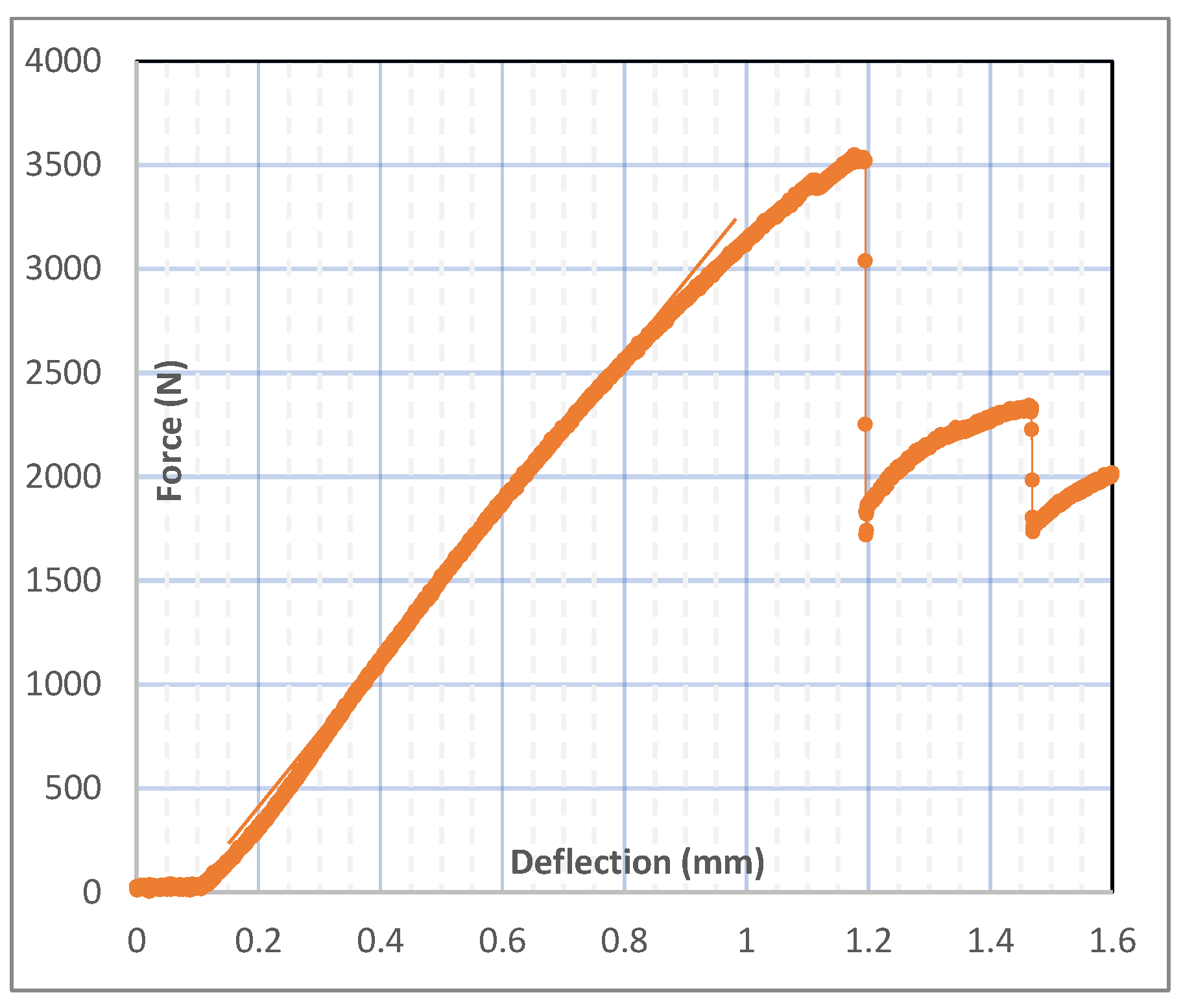
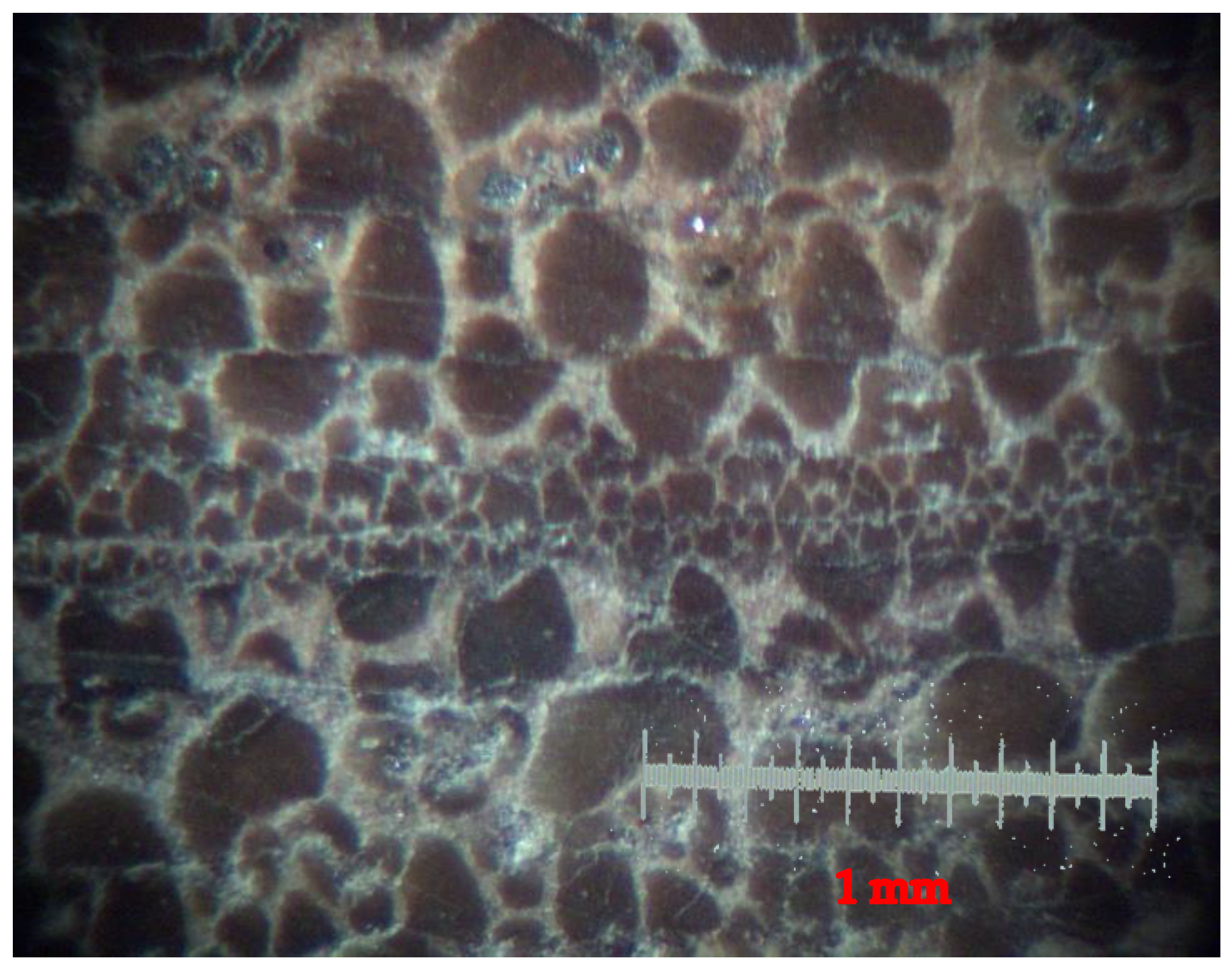

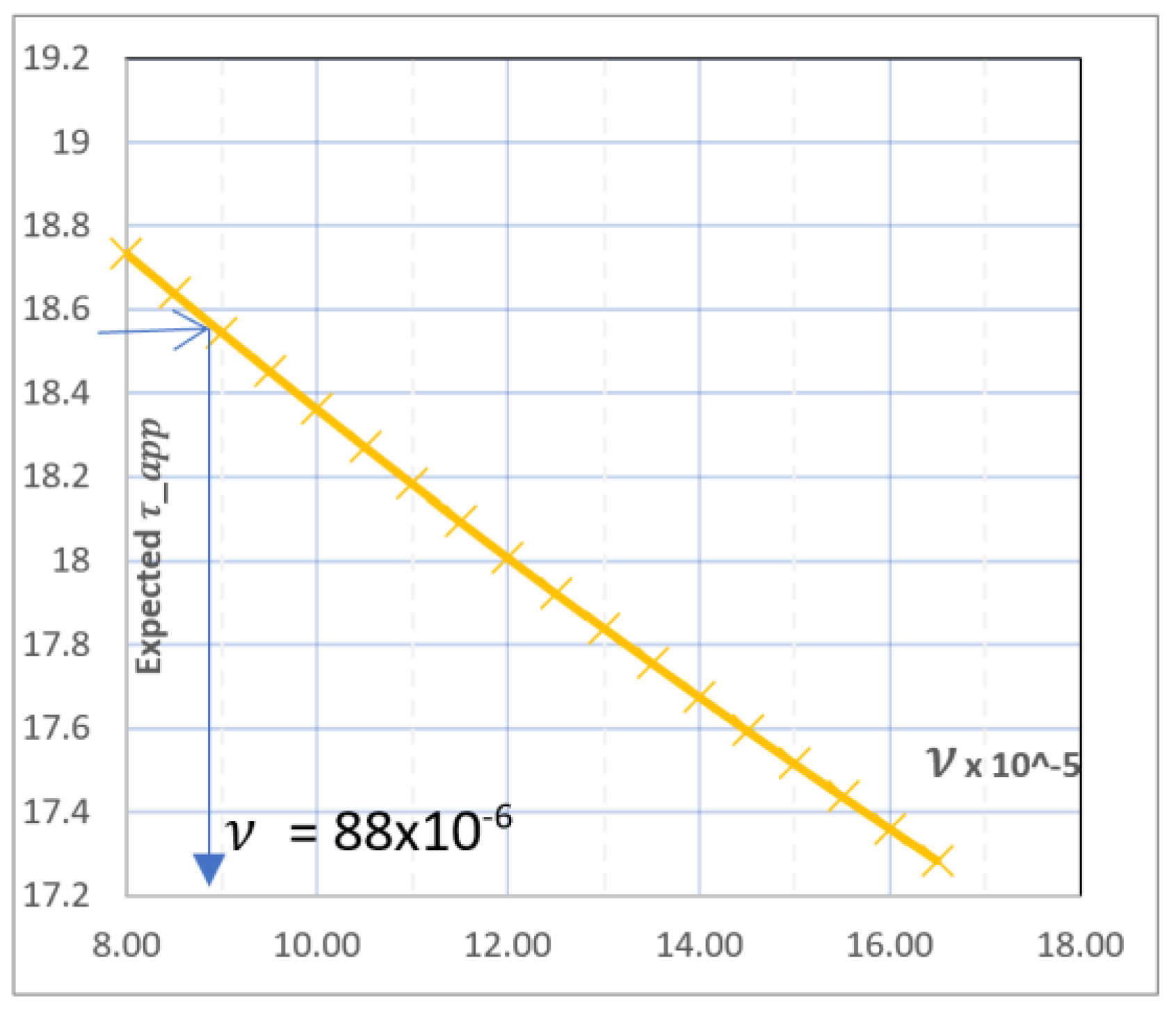
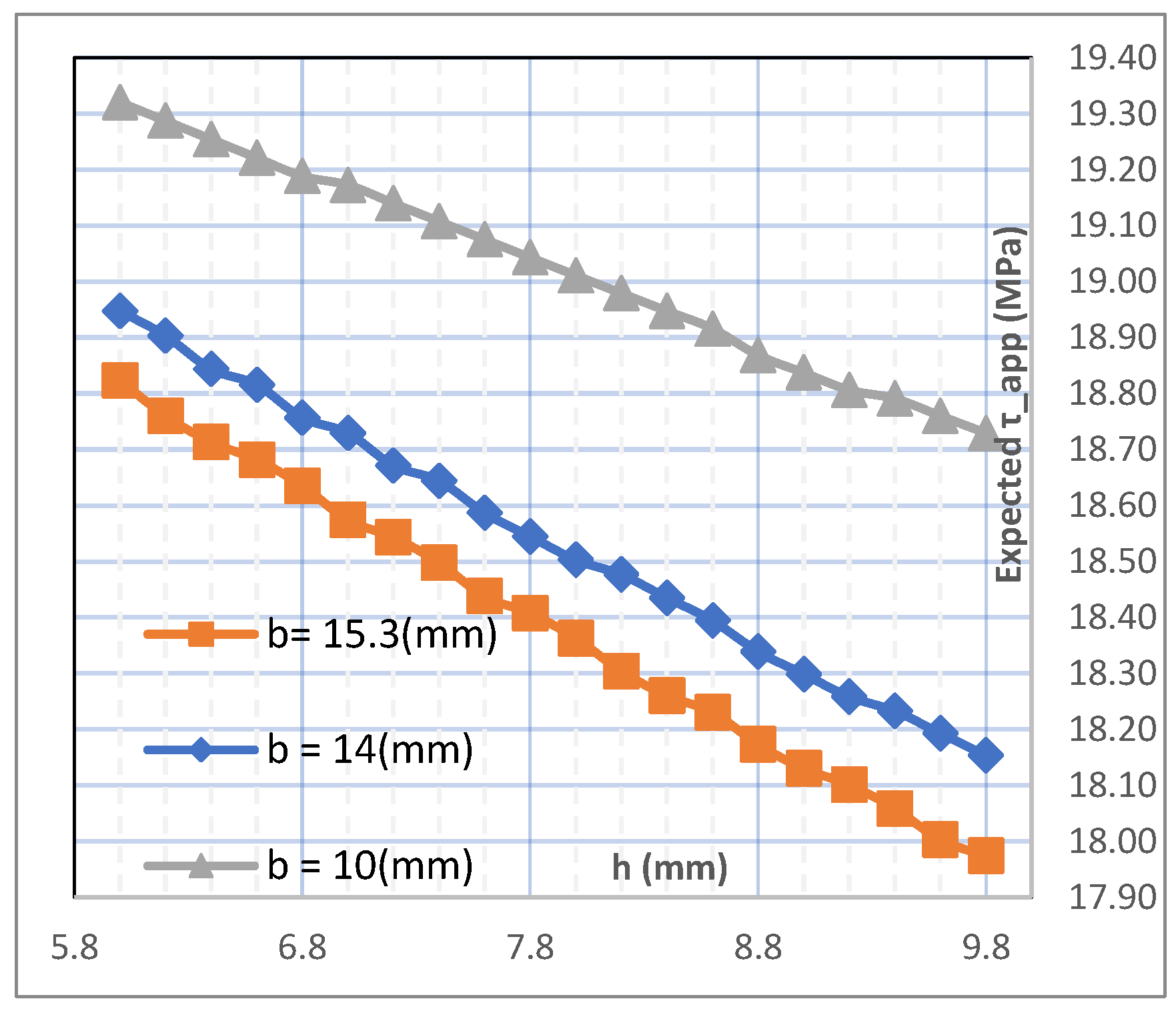
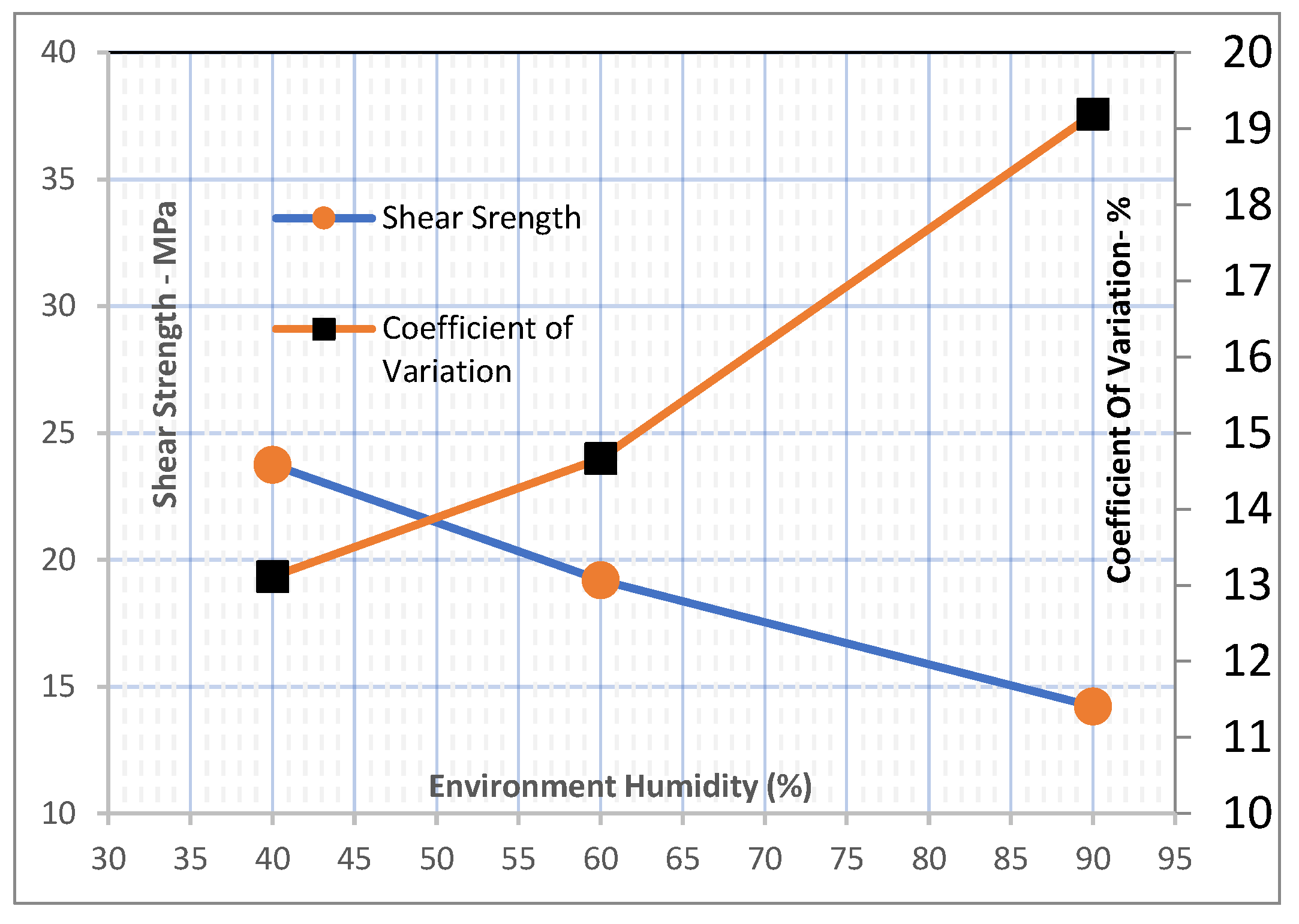
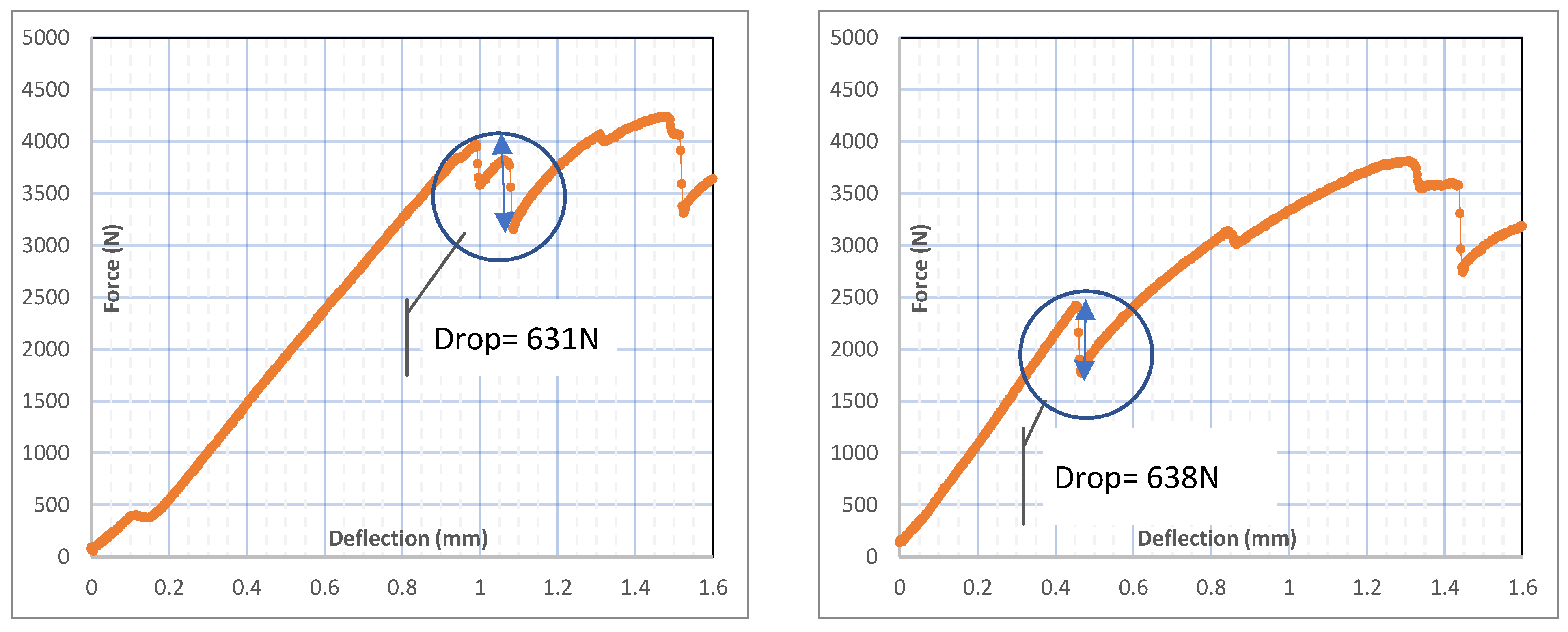
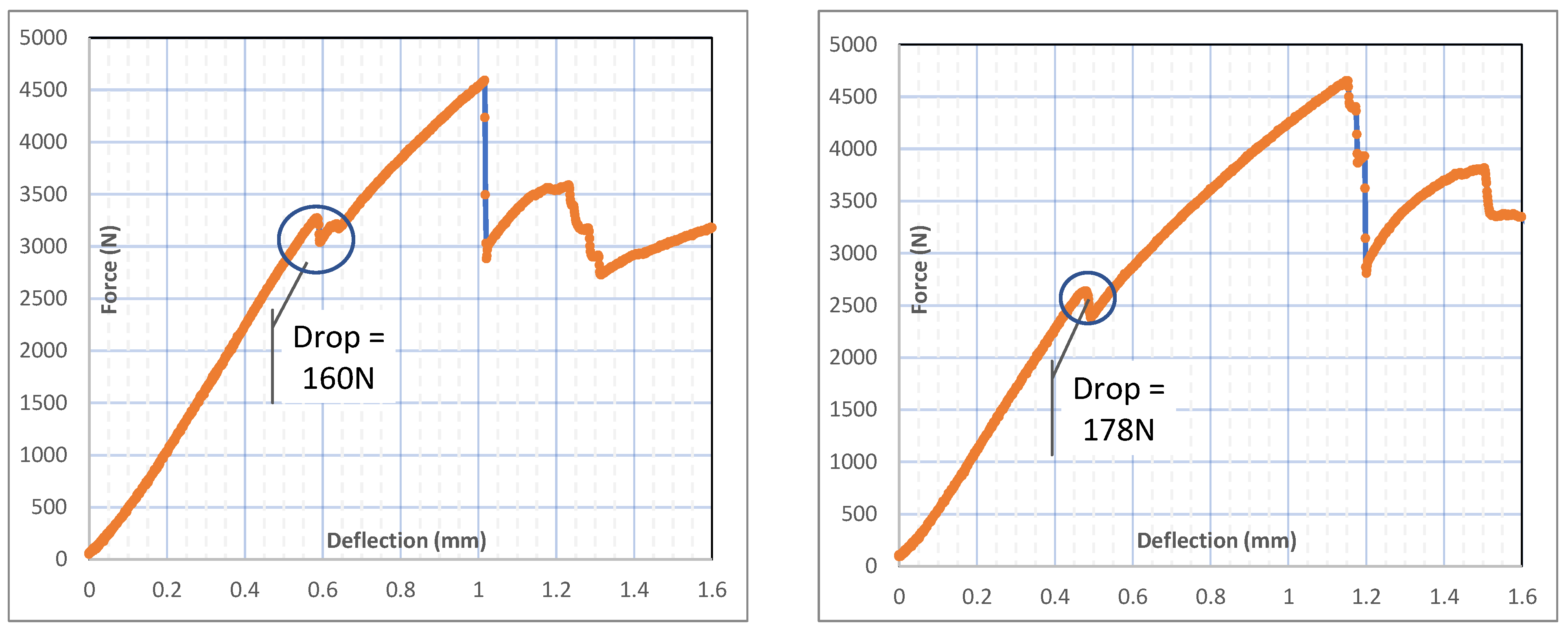
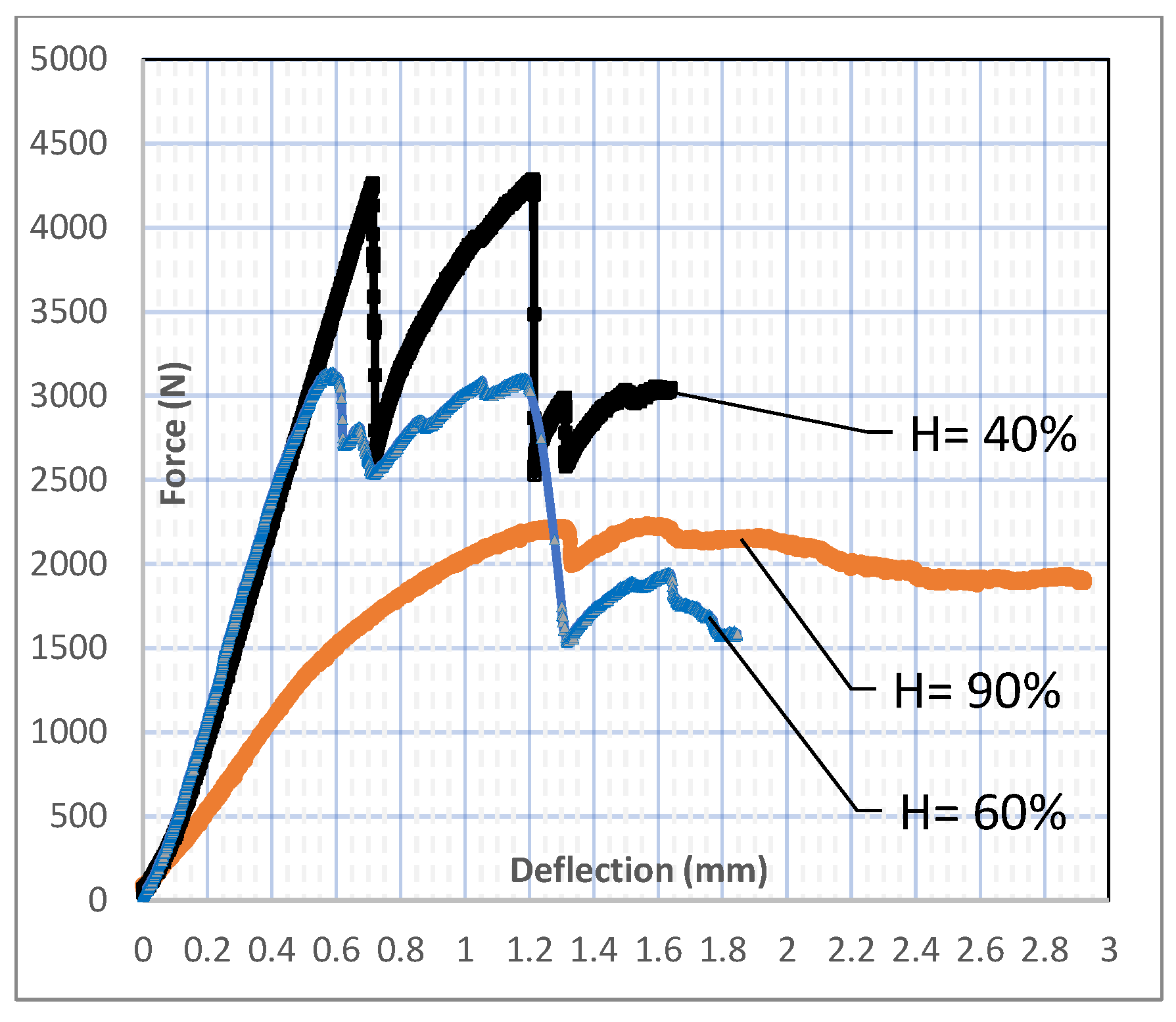
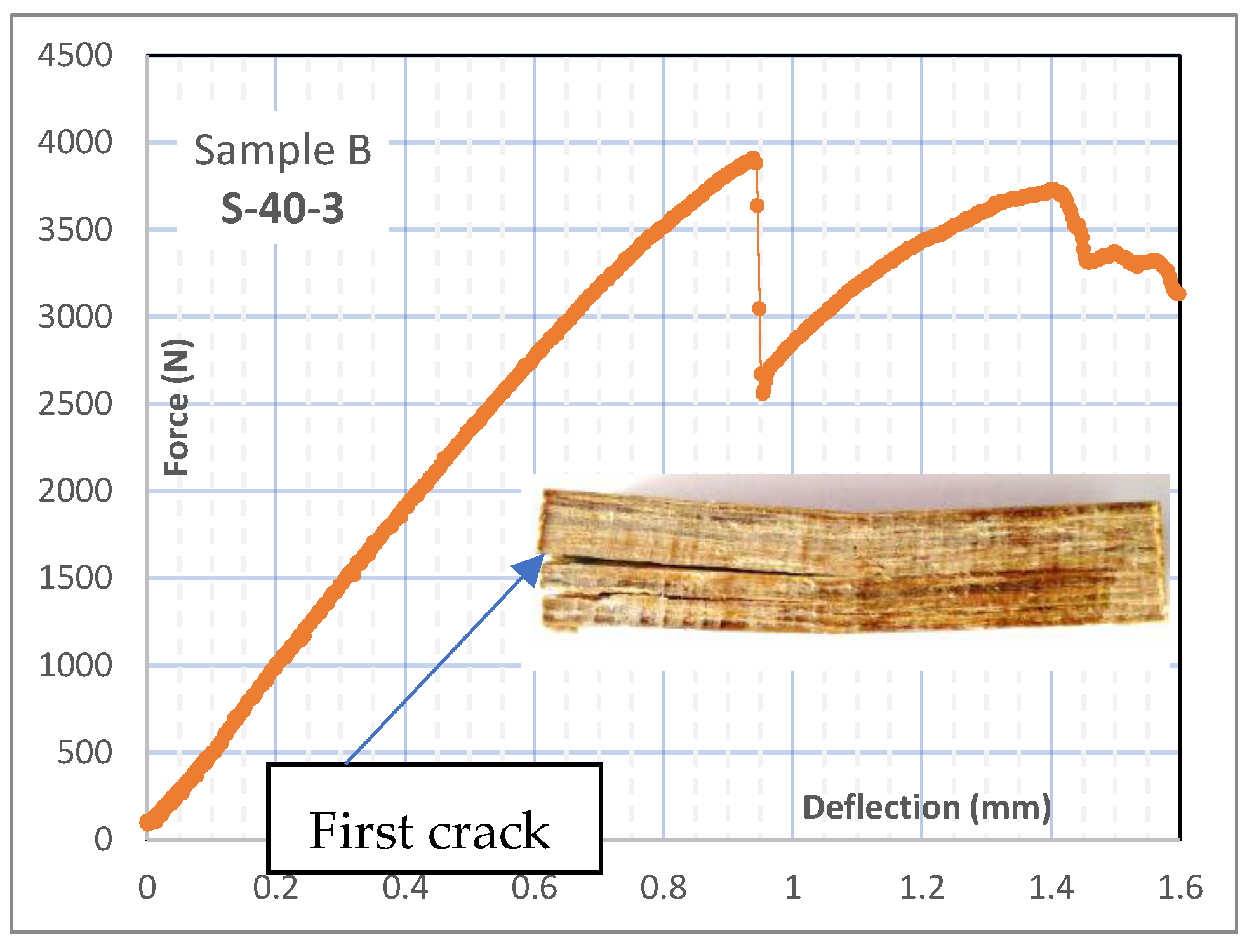
Publisher’s Note: MDPI stays neutral with regard to jurisdictional claims in published maps and institutional affiliations. |
© 2022 by the authors. Licensee MDPI, Basel, Switzerland. This article is an open access article distributed under the terms and conditions of the Creative Commons Attribution (CC BY) license (https://creativecommons.org/licenses/by/4.0/).
Share and Cite
Rajabipour, A.; Javadian, A.; Bazli, M.; Masia, M. Interlaminar Shear Properties of Bamboo Composite for Structural Applications. Fibers 2022, 10, 59. https://doi.org/10.3390/fib10070059
Rajabipour A, Javadian A, Bazli M, Masia M. Interlaminar Shear Properties of Bamboo Composite for Structural Applications. Fibers. 2022; 10(7):59. https://doi.org/10.3390/fib10070059
Chicago/Turabian StyleRajabipour, Ali, Alireza Javadian, Milad Bazli, and Mark Masia. 2022. "Interlaminar Shear Properties of Bamboo Composite for Structural Applications" Fibers 10, no. 7: 59. https://doi.org/10.3390/fib10070059





